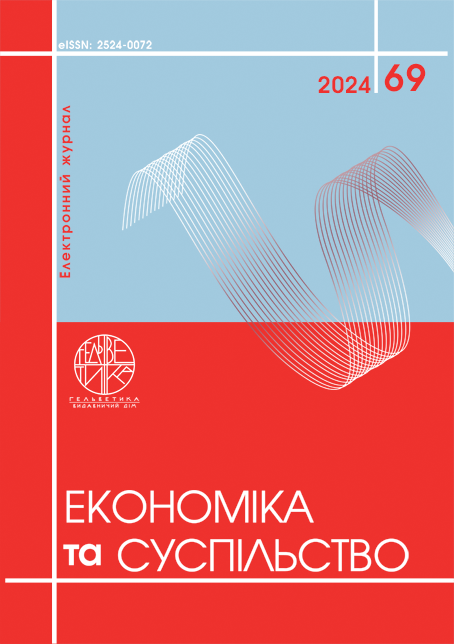ANALYSIS OF THE LEVEL OF DIGITALISATION IN AGRICULTURAL ENTERPRISES OF UKRAINE IN THE PERIOD OF MARTIAL LAW
Abstract
The article is dedicated to a comprehensive analysis of the level of digitalization of production processes in agricultural enterprises in Ukraine during the war period. This analysis covers a wide range of issues related to the implementation of digital technologies in the agricultural sector, particularly in areas such as precision farming, the use of geographic information systems (GIS), drones for crop monitoring, mobile applications for farm management, and online platforms for trading agricultural products. The authors examine not only the current state of digitalization but also the significant changes that have occurred in the agricultural sector due to the impact of the war on infrastructure, the economy, and access to digital resources. One important aspect of the article is the study of regional differences in the implementation of digital platforms. It is found that there are significant disparities in the level of digitalization between different regions of Ukraine. For example, central and western regions, such as Kyiv, Lviv, and Vinnytsia, have more developed infrastructure, which contributes to the implementation of modern technologies, while southern and eastern regions, due to destroyed infrastructure and ongoing military actions, face greater difficulties in this process. These regional differences are determined not only by geographic factors but also by access to financing, the level of local initiatives, and the willingness of local farmers to adopt new technologies. In the context of the war, most agricultural enterprises have faced the need to adapt to new circumstances, including limited internet access, the lack of proper technical support and infrastructure, and the destruction of some agricultural enterprises and farmland. This has posed a significant challenge to the effective use of digital platforms and technologies, as well as the provision of the necessary resources for adaptation to the new conditions. On the other hand, the war has demonstrated the need to develop digital solutions that can ensure the resilience of the agricultural sector in crisis situations. For example, innovative technologies such as satellite systems for crop monitoring and drones for assessing yields have become crucial tools for maintaining and managing agricultural enterprises under conditions of limited resources. The study also covers the prospects for the development of digital platforms for farmers after the end of the war. It is expected that after the country’s recovery, there will be a rapid development of innovations in the agricultural sector, particularly in the automation of production processes, the implementation of technologies for managing water resources, the use of artificial intelligence for yield forecasting, and the development of agricultural logistics. The article also discusses the importance of integrating blockchain technologies to ensure transparency and security in agricultural product supply chains. The main problems and barriers to digitalization of the agricultural sector identified in the research include the low level of technical preparedness of farmers, the lack of proper infrastructure in rural areas, high costs for implementing new technologies, and the lack of access to financing for small and medium-sized enterprises. The article provides specific recommendations for overcoming these difficulties, including the development of government programs to support digital technologies for farmers, expanding internet and mobile network access in rural areas, creating specialized training programs for farmers and agrarians, as well as providing grants and subsidies for small enterprises ready to implement digital solutions. In conclusion, the authors emphasize the importance of government support for the digitalization of the agricultural sector in both the short and long term. The article highlights that the development of digital technologies in agriculture is an essential component not only for post-war recovery but also for ensuring the sustainability, efficiency, and competitiveness of the agricultural sector in Ukraine in the global market. This research provides an in-depth understanding of the current challenges and opportunities for digitalization in Ukraine’s agricultural sector, offering a comprehensive approach to addressing problems and defining strategic directions for development during and after the war.
References
Антонова Г.В., Ковирьова О.В. Бездротові технології як ланка цифровізації сільського господарства. Комп’ютерні засоби, мережі та системи. 2018. № 17. С. 53–59.
Бортнік А. М. Цифрова трансформація бізнес-моделі підприємства. Стратегія економічного розвитку України. 2020. № 47. С. 16–31.
Вакуленко В., Мялковський В., Лю Ю. Оптимізація витрат виробництва продукції рослинництва на прифронтових територіях. Збірник наукових праць Державного податкового університету. 2024. Вип. 1. С. 3-7. URL: https://journals.dpu.kyiv.ua/index.php/collectioneconomy/article/view/452
Вакуленко В., Мялковський В., Сяовей Л. Організація системи інформаційного забезпечення управління витратами сільськогосподарських підприємств. Економіка та суспільство. 2023. Вип. 54. URL: https://economyandsociety.in.ua/index.php/journal/article/view/3214
Галицький О. М., Шабатура Т. С. Методологічне забезпечення захисту економічних інтересів інноваційного розвитку суб’єктів аграрного виробництва. Наукові записки Інституту законодавства Верховної Ради України. 2017. № 1. С. 123–131.
Дугінець Г., Ніжейко К. Цифровізація аграрного сектору ЄС: досвід для України. Економіка та суспільство. 2023. № 56.
Качанівська Ю. І. Економічна безпека сільськогосподарських підприємств. Науковий Вісник Львівського державного університету внутрішніх справ. 2015. № 1. С. 98–105.
Кір’ян О., Кононенко Я., Торяник Д. Інформаційна складова економічної безпеки організації. Цифрова економіка та економічна безпека. 2022. № 3 (03). С. 79–84.
Островський І.А. Міжнародні цифрові платформи як інструмент макроекономічного регулювання ринків аграрної продукції. Проблеми системного підходу в економіці. 2020. № 3(1). С. 21–25.
У 2023 році Україна продовжила посилювати європейський вектор аграрного експорту – ІАЕ. АПК-Інформ: веб-сайт. URL: https://www.apk-inform.com/uk/news/1539409 (дата звернення: 18.12.2024).
Шестакова А. В., Ткачук В. О., Мельник Т. Ю., Травін В. В. Цифрові можливості аграрної економіки України у воєнний період. Економіка, управління та адміністрування. 2022. № 3(101). С. 15–23.
Юрчук Н. П., Кіпоренко С. С. Розвиток технологій Big Data в умовах цифрових трансформацій. Агросвіт. 2021. № 9–10. С. 60–68.
Яцкевич І. В., Красностанова Н. Е. Цифрові технології у підприємницькій діяльності. Економічний вісник Дніпровської політехніки. 2021. № 1. С. 38–44.
Kernel запустив онлайн-платформу Open Agribusiness для аграріїв. URL: https://agroreview.com/content/kernel-zapustyv-onlajn-platformu-open-agribusiness-dlya-ahrariyiv/ (дата звернення: 18.12.2024).
Vakulenko V., Xiaowei L. (2022) Formation of information support system for the management of agricultural enterprises. Economics & Education, vol.7.3, pp. 6–11. URL: http://www.baltijapublishing.lv/index.php/econedu/article/view/1958
Antonova, G. V., & Koviryova, O. V. (2018) Bezdrotovi tekhnolohii yak lanka tsyfrovizatsii silskoho hospodarstva [Wireless Technologies as a Link in the Digitalization of Agriculture]. Kompiuterni zasoby, merezhi ta systemy – Computer Tools, Networks and Systems, vol. 17, pp. 53–59.
APK-Inform. [APK-Inform]. (n.d.). Available at https://www.apk-inform.com/uk/news/1539409 (accessed 18.12.2024)
Bortnik A. M. (2020) Tsyfrova transformatsiia biznes-modeli pidpryiemstva [Digital Transformation of Business Models]. Stratehiia ekonomichnoho rozvytku Ukrainy – Strategy of Economic Development of Ukraine, vol. 47, pp. 16–31.
Halytsky, O. M., & Shabatura, T. S. (2017) Metodolohichne zabezpechennia zakhystu ekonomichnykh interesiv innovatsiinoho rozvytku subiektiv ahrarnoho vyrobnytstva. [Methodological Provision for the Protection of Economic Interests in Innovative Development of Agricultural Production Entities]. Naukovi zapysky Instytutu zakonodavstva Verkhovnoi Rady Ukrainy – Scientific Notes of the Institute of Legislation of the Verkhovna Rada of Ukraine, vol. 1, pp. 123–131.
Duhinets, G., & Nizheiko, K. (2023) Tsyfrovizatsiia ahrarnoho sektoru YeS: dosvid dlia Ukrainy [Digitalization of the Agricultural Sector in the EU: Experience for Ukraine]. Ekonomika ta suspilstvo – Economy and Society, vol. 56.
Kachanivska, Y. I. (2015) Ekonomichna bezpeka silskohospodarskykh pidpryiemstv [Economic Security of Agricultural Enterprises]. Naukovyi Visnyk Lvivskoho derzhavnoho universytetu vnutrishnikh sprav – Scientific Bulletin of the Lviv State University of Internal Affairs, vol. 1, pp. 98–105
Kernel zapustyv onlain-platformu Open Agribusiness dlia ahrarii [Kernel. (n.d.). Kernel launched an online platform Open Agribusiness for farmers]. Available at: https://agroreview.com/content/kernel-zapustyv-onlajn-platformu-open-agribusiness-dlya-ahrariyiv/ (accessed 18.12.2024)
Kirian, O., Kononenko, Y., & Toryanik, D. (2022) Informatsiina skladova ekonomichnoi bezpeky orhanizatsii [Information Component of Economic Security of an Organization]. Tsyfrova ekonomika ta ekonomichna bezpeka – Digital Economy and Economic Security, vol. 3(03), pp. 79–84.
Ostrovsky, I. A. (2020) Mizhnarodni tsyfrovi platformy yak instrument makroekonomichnoho rehuliuvannia rynkiv ahrarnoi produktsii [International Digital Platforms as a Tool for Macroeconomic Regulation of Agricultural Product Markets]. Problemy systemnoho pidkhodu v ekonomitsi – Problems of the System Approach in the Economy, vol. 3(1), pp. 21–25.
Shestakova, A. V., Tkachuk, V. O., Melnyk, T. Yu., & Travin, V. V. (2022). Tsyfrovi mozhlyvosti ahrarnoi ekonomiky Ukrainy u voiennyi period [Digital Opportunities of the Agricultural Economy of Ukraine during the War Period]. Ekonomika, upravlinnia ta administruvannia – Economy, Management and Administration, vol. 3(101), pp. 15–23.
Vakulenko V., Mialkovskyi V., Liu Y. (2024) Optimizaciya vitrat virobnictva produkcii roslinnictva na prifrontovih teritoriyah [Optimization of crop production costs in the frontline areas]. Zbirnik naukovih prac Derzhavnoho podatkovoho universitetu [Collection of scientific papers of the State Tax University]. vol. no. 1. pp. 3-7. Available at: https://journals.dpu.kyiv.ua/index.php/collectioneconomy/article/view/452
Vakulenko V.L., Mialkovskiy V.A., Xiowei L. (2023). Organizaciya systemi informaciynogo zabezpechennya upravlynnya vytrat vytratamy silskogospodarskogo pidpriemstva [Organization of information support system for cost management of agricultural enterprises]. Ekonomika ta suspilstvo [Economy and society]. vol. no. 57. Available at: https://economyandsociety.in.ua/index.php/journal/article/view/3214
Vakulenko V., Xiaowei L. (2022) Formation of information support system for the management of agricultural enterprises. Economics & Education, no. 7(3), pp. 6–11. Available at: http://www.baltijapublishing.lv/index.php/econedu/article/view/1958
Yatskevich, I. V., & Krasnostanova, N. E. (2021) Tsyfrovi tekhnolohii u pidpryiemnytskii diialnosti [Digital Technologies in Entrepreneurial Activity]. Ekonomichnyi visnyk Dniprovskoi politekhniky – Economic Bulletin of Dnipropetrovsk Polytechnic, vol. 1, pp. 38–44.
Yurchuk, N. P., & Kiporenko, S. S. (2021) Rozvytok tekhnolohii Big Data v umovakh tsyfrovykh transformatsii [Development of Big Data Technologies in the Context of Digital Transformations] Ahrosvit – Agrosvit, vol. 9–10, pp. 60–68.

This work is licensed under a Creative Commons Attribution 4.0 International License.


